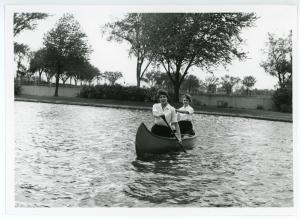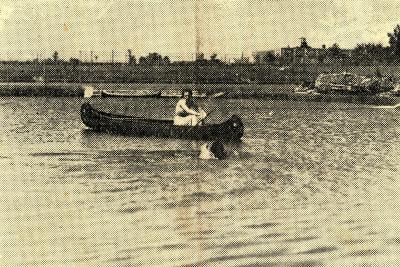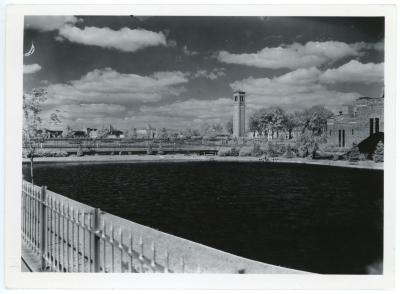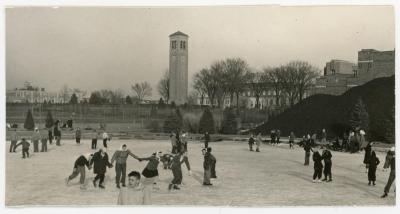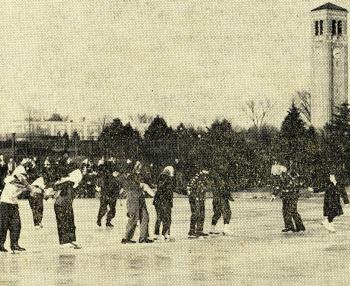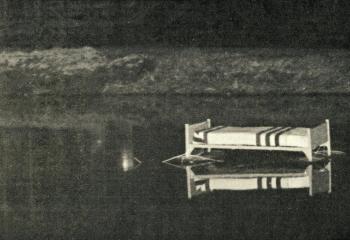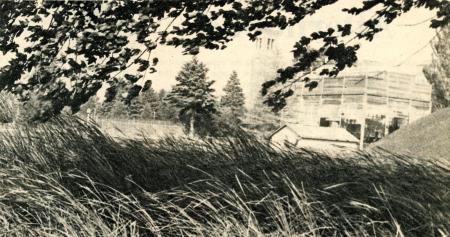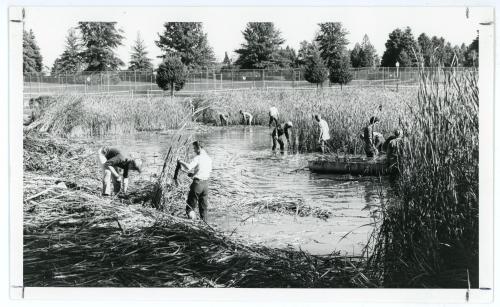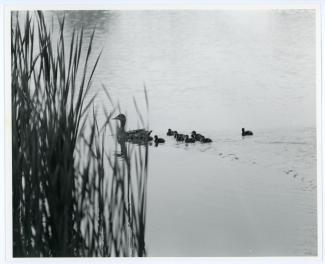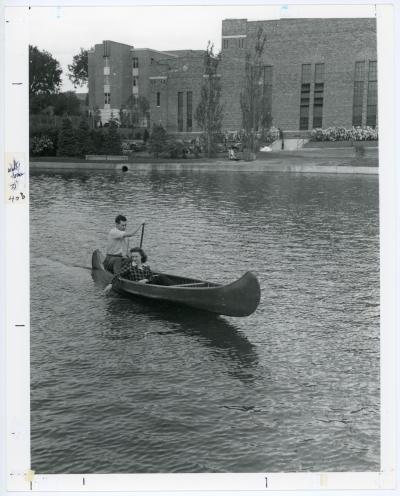Prexy's Pond, located on a portion of the site now occupied by the Curris Business Building and the open area to the south of that building, was a landmark on the University of Northern Iowa campus for over fifty years. It was part of the development of what was, in the 1930s, the southern edge of campus. Other parts of this development included Baker Hall, then a men's dormitory, and a new power plant. Prexy's Pond was constructed to meet curricular and recreational needs. The pond was not, as some have surmised, built as a source of cooling water for the adjacent power plant. The low, wet nature of that particular area of campus made it a good site for a pond. For about the first half of its existence, Prexy's Pond was a scenic, pleasant place on the edge of campus where students could relax. For the latter half of its life it was an unattractive maintenance nightmare.
Early History of Prexy's Pond
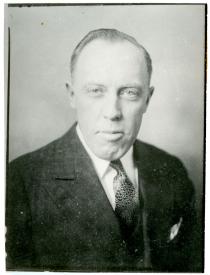 For many years, the Department of Physical Education for Women offered canoeing classes to its students. The classes were offered on the Cedar River near downtown Cedar Falls, the closest navigable water. But that site was far from ideal. First, it was a long way from campus; time was lost in getting to and from the site. Second, the water level on the river was unpredictable; it could be high after heavy rains or low with sandbars and visible rocks. And third, canoeing on the river could be dangerous for inexperienced boaters; deep holes and a swift current made the river hazardous. When the downtown Cedar Falls dam washed out in the early 1930s, leading to continued low water levels, the situation came to a head. Professors Monica Wild and Doris White of the Department of Physical Education for Women asked President Latham if a pond could be constructed on campus for their classes. Since a portion of the campus drained toward the southwest, a low site on the south side seemed appropriate.
For many years, the Department of Physical Education for Women offered canoeing classes to its students. The classes were offered on the Cedar River near downtown Cedar Falls, the closest navigable water. But that site was far from ideal. First, it was a long way from campus; time was lost in getting to and from the site. Second, the water level on the river was unpredictable; it could be high after heavy rains or low with sandbars and visible rocks. And third, canoeing on the river could be dangerous for inexperienced boaters; deep holes and a swift current made the river hazardous. When the downtown Cedar Falls dam washed out in the early 1930s, leading to continued low water levels, the situation came to a head. Professors Monica Wild and Doris White of the Department of Physical Education for Women asked President Latham if a pond could be constructed on campus for their classes. Since a portion of the campus drained toward the southwest, a low site on the south side seemed appropriate.
The student newspaper, the College Eye, announced in May and June, 1935, that Superintendent of Buildings and Grounds E. E. Cole would be filling a new pond just west of Baker Hall. The dimensions of the pond would be fifty by eighty yards, with a depth varying from about two-and-one-half to four feet. The pond would hold about 525,000 gallons of water. The pond would also be available as a recreational ice rink in the winter. There would be an inlet on the east side and an outlet, with a water gate, in the southwest corner. The banks would be sodded and stone flagging would extend below the surface. Officials hoped that the pond would "add greatly to the beauty of the campus."
By July 10, 1936, the pond was filled and students were taking out canoes on it. Although the pond was not intended as a swimming pool, more than just the student pictured below found himself or herself taking a voluntary or involuntary dip in it.
The pond quickly became a favorite spot on campus and a home for several traditional activities. During the late 1930s and 1940s it might well have been the most heavily photographed site on campus, other than the Campanile.
By February 1937, the college pond was in use as a skating rink for the Women's Athletic Association Ice Carnival. The WAA committee planned to get everyone who owned or could borrow a pair of skates out on the ice. There would be racing, bright lights, and music. These carnivals or winter frolics became a regular feature of college life at least through the 1940s.
They became more elaborate over the years until they included skating performances, square dances, food, and, if conditions permitted, snow sculpture contests. In September 1940 the pond was the site of a dormitory sing. Groups representing all four of the campus residence halls gathered there for a singing contest.
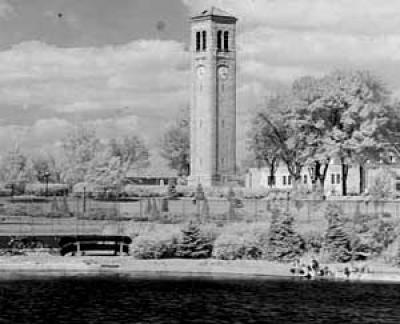
A Note on the Name of the Pond.
Prexy's Pond seems never to have received an official name. Initially it was known as the College Pond or simply The Pond. But an article in a July 1941 issue of the College Eye referred to it as "Latham Pond". Latham was the last name of Orval Ray Latham, who was president of the school from 1928 until his unexpected death in 1940. The pond seems to have been named for him after his death, at least unofficially, because he was the college administrator most responsible for its creation. By August 1941 the name Prexy's Pond appears in print. Prexy is a slang term for President. At least as late as 1942 the name College Pond still appears, but Prexy's Pond (with the occasional alternate spelling Prexie's Pond) was the popular name that stuck.
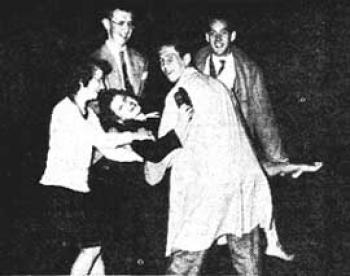
The pond was the site for many organized college activities. However, it also became the site for less formal activities, such as the hazing and initiation of freshmen, who usually ended up dunked in the cold water of the pond. The September 14, 1945, issue of the College Eye reported one such incident:
"Prexy's pond it seems was the scene of more than one interesting adventure this week. For instance, last Monday, two senior football players decided they would like to learn something about the swimming ability of one freshman football player. The freshman, it was discovered, is an excellent swimmer, and fortunately the two seniors can swim, too, because the freshman football player was also one of the better high school wrestlers in the state last year."
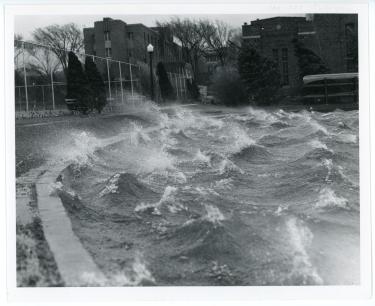
Not everyone thought that this rough-housing was a humorous or even acceptable part of college life. An editorial in the College Eye in September 1947 called upon the administration "to put an end to this childish hazing before Prexy's Pond becomes a monument to a tragedy." Later that month student columnist Warren Smith conducted a poll of students on the dunking of freshmen. He found that 49% of students thought that the practice should be stopped, 41% thought that it should continue, and 10% had no opinion. The practice continued as a recognized part of college life at least through 1952. Critics of dunking cited its silliness and potential danger. Proponents cited the preservation of a tradition. The 1952 "dunking" consisted of freshmen voluntarily wading into the pond, giving a cheer, singing the loyalty song, and then hurrying home to change into dry clothes. In September 1953 the student government, then known as the Student League Board, approved a resolution that would abolish dunking in Prexy's Pond. While this was the official end of dunking, evidence indicates that the practice continued, at least on a smaller and less organized scale, until well into the 1960s.
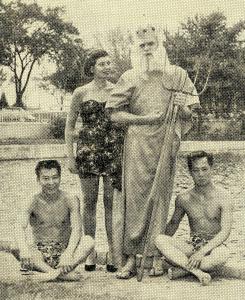
The pond required at least a certain amount of maintenance over the years. An equipment shed was built on the eastern side of the pond. A portion of the original earthen and flagstone wall was replaced by concrete in the summer of 1939. That concrete wall was replaced by a new wall in 1955. But several College Eye writers noted that the pond itself had a generous assortment of cans and broken bottles lining its bottom, certainly a matter of concern for anyone who might be dunked.
In May 1956 the "Yacht Club" of the men's residence hall sponsored an Aqua Festival at Prexy's Pond. With tongues planted firmly in cheeks, the men promised the appearance of marathon swimmers named One Lungstrom and Baron von Stravius, as well as Queen Beth and King Neptune. Queen Beth would be rowed ceremoniously across the pond to meet the king.
Over the years this relatively quiet corner of campus had also been attractive to romantic couples. The College Eye of October 3, 1958, reports on one well-dressed couple that "got too close to the edge--evidently were concentrating on other things as they walked along--yep--they both fell in!" Wet shoes, soaked cashmere sweaters, and injured dignities were the result.
Later History of Prexy's Pond
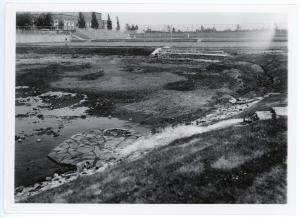 Over time the pond became something less than a thing of beauty. A writer in 1958 referred to the pond as a "weed-infested lagoon". Since the pond was created by retaining run-off water with a dam on its southern edge, it was occasionally flushed and cleaned by lifting the dam gate and letting the water drain away. In 1963 the Physical Plant Department reported on plans to clean the pond once again but also noted that long term plans called for its removal.
Over time the pond became something less than a thing of beauty. A writer in 1958 referred to the pond as a "weed-infested lagoon". Since the pond was created by retaining run-off water with a dam on its southern edge, it was occasionally flushed and cleaned by lifting the dam gate and letting the water drain away. In 1963 the Physical Plant Department reported on plans to clean the pond once again but also noted that long term plans called for its removal.
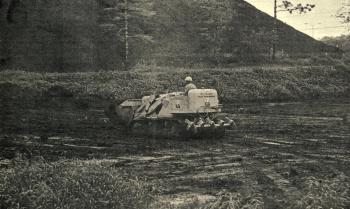
In 1964 Melvin Manion, Associate Director of the Physical Plant, voiced considerable frustration with the condition of the pond. Mr. Manion believed that the shabby condition of the pond was due at least partially to the construction of Russell Hall and the Regents residence hall complex just west and south of the pond. The installation of storm sewers associated with these projects altered and reduced the natural flow of water that earlier had flushed the pond regularly. Sediment, algae, and cattails built up in the increasingly stagnant pond. In addition, run-off from the coal pile just east of the pond discolored the walls and bottom of the pond. A College Eye writer in 1966 referred to it as "a smelly, red-tinged tennis ball trap".
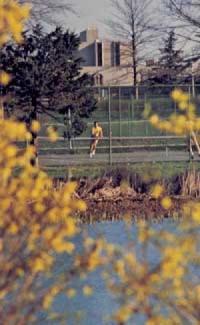
Despite, or, perhaps, because of the unattractive condition of the pond, the university made at least one more major effort to restore Prexy's Pond. The situation had deteriorated to the point that the pond would no longer hold water. So, in the summer of 1968 the pond was drained, the sides were rebuilt, and the bottom was lined with a new coat of clay to enable it to hold water.
The pond was refilled in August 1968. Daryl Pendergraft, Executive Dean of the University, recalled that fish had been stocked in the pond in earlier years. He said that they flourished there and even responded to students who fed them popcorn along the banks. However, runoff from the coal pile doomed the fish. Following the 1968 restoration, the university planned to clean up and landscape the banks of the pond, but there were no plans to stock it with fish again.
Students responded to the beautification project, but probably not in a way that the university administration had anticipated.
Using similar events in Chicago and San Francisco as models, a group of students designated September 19, 1969, as "Bra-less Friday". That day culminated with about 2500 students congregating around Prexy's Pond. Some climbed trees and fences for a better view. Exactly what they saw from their perches on that "Bra-less Friday" is probably better left to the imagination, but some students ended up in the pond.
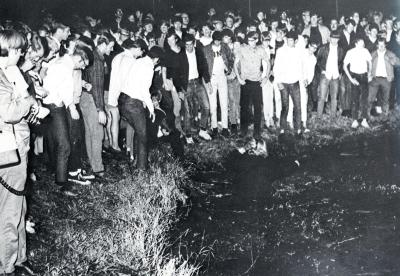 Activities for the winter of 1969-1970 were a bit more staid as students and local children enjoyed ice skating on the frozen pond.
Activities for the winter of 1969-1970 were a bit more staid as students and local children enjoyed ice skating on the frozen pond.
By 1972 the Northern Iowan reported that the pond was again choked with reeds and cattails.
Just a few days after the article appeared, a group of men from Boies House of Rider Hall waded into the pond and pulled weeds all day until the pond was once again clear.
Just about everyone praised the work of Boies House, though, in those days of heightened environmental awareness, at least a couple of people thought that the pond should have been left in its natural state, covered with cattails.
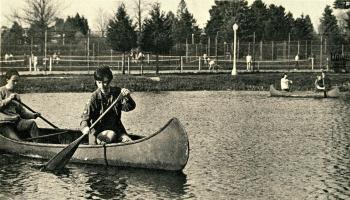
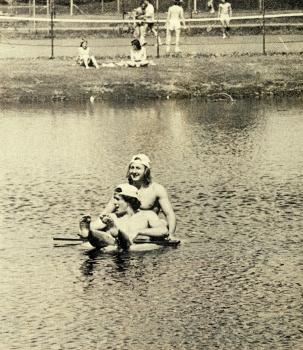
Administrators talked about building a wall that would keep coal pile runoff out of the pond and drilling a well to supply fresh water to replenish the pond on a continuous basis. Such projects would have cost $800,000-$900,000. But no money ever materialized for these dreams.
Prexy's Pond continued to function as a skating rink during winters of the late 1970s and early 1980s but its days were numbered.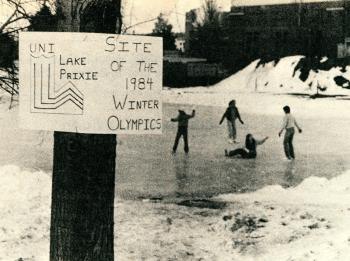
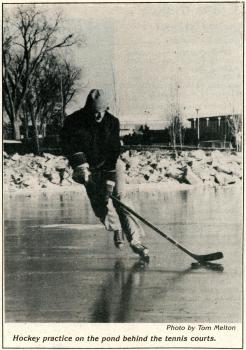
.
In December 1986, the university announced its decision to build a new business classroom building on the site of the pond. In defending the site selection, Director of Planning Lee Thomson stated, "The present pond is a mess. We are looking at the area to see if we can utilize a water area around the new building." He noted that Prexy's Pond was in such poor condition that it would need to be deepened or moved in any case.
Feature writers and cartoonists in the Northern Iowan, notably Paul Marlow, complained, generally in good nature, about the loss of Prexy's Pond. Their somewhat less than serious rallying point centered on the mallard ducks that would lose their home when the pond was filled in. In his cartoon fantasy, Mr. Marlow pitted the ducks against their purported adversary, UNI President Constantine Curris.
Despite these mild grumblings, Prexy's Pond was indeed destroyed when construction began on the new business building in July 1988.
There was a certain amount of nostalgia among students in the years immediately following the destruction of the pond. In fact, the Class of 1993 made a new pond their top choice in a poll to select a class gift. The senior gift committee even went so far as to offer two potential sites for the new pond: south of the new business building or near the performing arts building (now Gallagher-Bluedorn Performing Arts Center) that was then in the planning stage.
Nothing, however, came of these plans for a new pond. Perhaps the Class of 1993 did not think the project worthwhile and did not contribute enough money. Perhaps campus officials had concerns about introducing a potentially troublesome water feature on campus. It seems likely that a campus pond similar to Prexy's Pond is gone from the UNI campus forever.
Summary
For a good portion of its life, Prexy's Pond was beneficial to the campus. It served as a classroom for physical education classes and as a recreational space for winter sports. It even became the site of several traditional campus activities including the Winter Carnival, dormitory contests, and freshman initiations. When it was built, Prexy's Pond was on the edge of campus. It filled and drained naturally to provide a pleasant, quiet space in which students could relax. As the campus developed to the south and west, Prexy's Pond functioned less well as either a natural feature or a recreation area. The pond became hazardous and expensive to maintain. It was probably not an especially hard choice to decide to build the new business building on that site. The construction of the building and the consequent elevation of the site make it difficult for current students even to visualize how a pond could have been located there. But many UNI alumni probably remember the beauty of Prexy's Pond in its early days and the fun that they had there.
Compiled by University Archivist Gerald L. Peterson, with research assistance by Student Assistant Shanna Taylor and scanning by Library Assistant Gail Briddle, June 2005; last updated October 20, 2011 (GP); photos and captions updated by Graduate Assistant Eliza Mussmann March 28, 2023.

